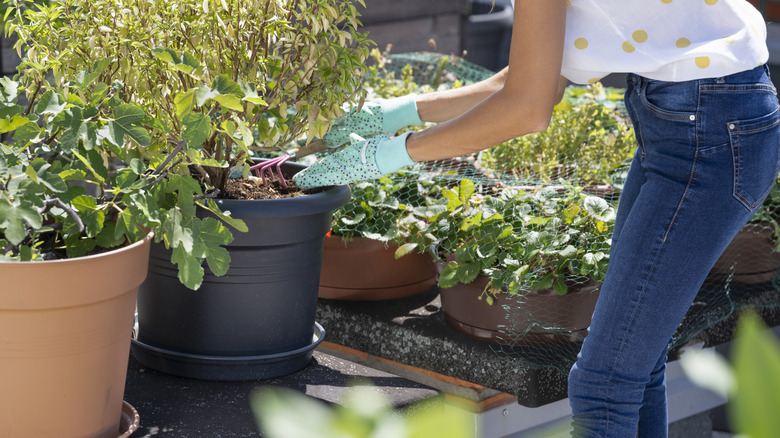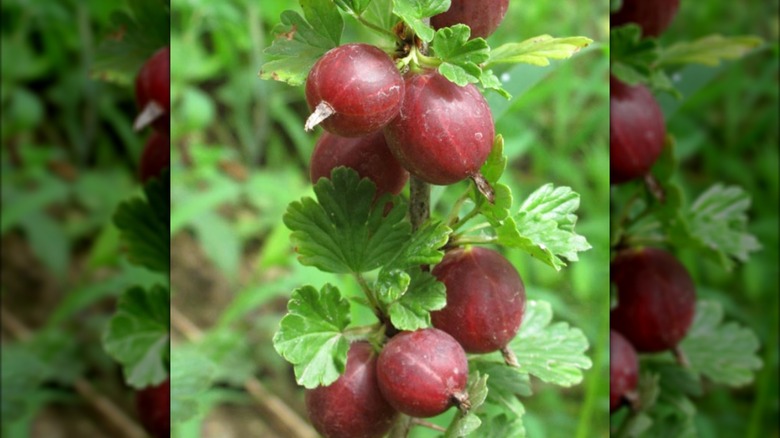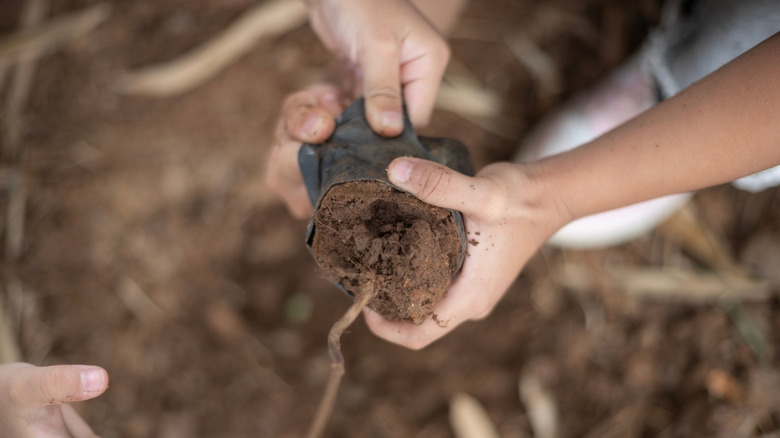The Small Fruit Bush That's Great For Container Gardening
If a plant creates thorns and sour berries, it makes sense that its name could be synonymous with mischief. While you don't commonly hear mischievous acts referred to as a "playing gooseberry" nowadays, the namesake bush's tricky qualities could explain the added meaning for its name. The spikes and mouth-puckering fruit of the gooseberry bushes might feel prank-worthy, but not all types of these berry shrubs have these slightly unpleasant characteristics. Learn a bit about the captivator gooseberry (Ribus uva-crispa 'Captivator'), a fruiting bush that defies its family's naughty reputation.
This small fruit bush, like other types of gooseberry, has shallow roots that take well to growing in a container. Yes, there is such a thing as container gardening for trees and bushes, and this "captivating" berry shrub will grow happily on your patio or deck in zones 3 to 8. It reaches a modest 3 to 5 feet in height and width and is self-pollinating, which adds to its low-maintenance and small-space-friendly characteristics.
This plant has few of the downfalls that gooseberries are known for; they have hardly any thorns, are resistant to diseases, and the fruit are tasty enough to be considered "dessert" quality. Order yourself the 'Captivator' as a new addition to your container garden. They're likely to come bare-root if you order them online or in a pot from a local nursery.
Prepping the 'Captivator' for potting
Planting gooseberries in containers is a smart way to enjoy growing fruit trees when you don't have much room. The 'Captivator' grows well in colder climates, but container-dwelling ones shouldn't be exposed to temperatures below 20 degrees Fahrenheit. In chillier climes, plant the 'Captivator' in pots outdoors once your temps in your area are likely to stay above 20 degrees for the season. In regions with particularly hot summers, plant gooseberries outdoors in pots in the fall so that they can become established before the heavy heat sets in.
Source a pot that's about twice as wide as the root ball and between a few inches deeper for potted plants and a foot deeper for bare-root plants. Add well-draining soil to the pot. If you notice girdling roots (ones that coil around the trunk), cut them to keep them from strangling the plant before potting. Also trim away any roots that are broken or too long. For potted gooseberries, loosen the roots by scoring the sides of the root ball with a trowel.
Planting and maintaining the 'Captivator'
Bare-root plants need to hit the soil quickly, and you should soak the roots in a bucket of water for about 12 hours before planting. Keep plants in water up until the point you put it in soil. As you plant your gooseberry tree, spread the roots out in the hole. Fill the area around the plant halfway with soil, then water it thoroughly before adding the rest of the soil. For bare-root plants, cover the lowest branch with soil as well to help it grow into bush form. Plant potted gooseberries about 2 inches lower than they sat in their nursery pots.
If you give it the right care, your 'Captivator' gooseberry could be around for decades. Place the pots in full or part sun, and water your potted 'Captivator' regularly, since container-bound plants dry out much more quickly than ones planted directly in the ground. Also, provide them enough at each watering so that excess washes out of the pots' drains. This helps wash away salt buildup that can harm the plant.
It can be challenging to choose and apply the right fertilizer for your fruit trees. Treat your gooseberry trees to a balanced fertilizer at the end of winter. The University of Connecticut recommends using a 10-10-10 fertilizer mix. They also suggest giving first-year plants a dose right at planting as well as 4 to 6 weeks later.


